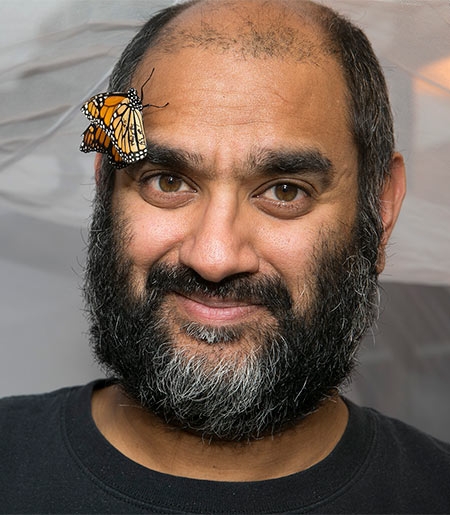
We plant three species of milkweed (the host plant for the monarchs), but both the monarchs and the honey bees gravitate toward A. curassavica, a non-native. So do syrphid flies, carpenter bees, bumble bees, leafcutter bees and assorted other insects.
If you haven't heard, planting tropical milkweed is controversial. Scientific research shows that it disrupts the monarch migration patterns when it's planted outside its tropical range, and can lead to the spreading of OE, orophryocystiselektroscirrha, a protozoan parasite that infects monarch and queen butterflies. (See Exposure to Non-Native Tropical Milkweed Promotes Reproductive Development in Migratory Monarch Butterflies, published by the National Center for Biotechnology Information, U.S. National Library of Medicine, Bethesda, Md. Also see the Xerces Society for Invertebrate Conservation website on the issue.)
UC Davis alumnus and monarch expert Anurag Agrawal of Cornell University, the James A. Perkins Professor of Environmental Studies at Cornell University and the author of the celebrated book, Monarchs and Milkweed: A Migrating Butterfly, a Poisonous Plant, and their Remarkable Story of Coevolution (2017 Princeton University), knows the controversy well.
"Tropical milkweed is an interesting and complex issue," he recently told us. "I love the plant for various reasons, but there is growing evidence that as it has become weedy (and self-seeding) in the southeastern United States and California. It is affecting monarchs, mostly by disrupting their migration. The key issue here is that when it is flowering 'out of season' this can be 'confusing' to monarchs. Having said this, we don't live in a pristine world, so my position is that we need moderation in the approach to tropical milkweed. It is certainly an easy plant to grow and monarchs can make good use of it during the caterpillar season. If you love the plant, go for it, but I would recommend cutting in back before the migratory season starts."
Agrawal received his doctorate from UC Davis. Read a review of his Monarchs and Milkweed book from the journal Ecology and read the first chapter here. You can order the book here.
Three Milkweed Species
We offer monarchs a choice of milkweed species in our Vacaville pollinator garden. In addition to the non-native A. curassavica, we plant two native species: narrowleaf milkweed, A. fascicularis, and showy milkweed, A. speciosa. In July, we collected 11 caterpillars from the narrowleaf milkweed; we rear them to adulthood and release them into the neighborhood. But in the numbers game, the tropical milkweed won. From July through today, we have collected a whopping 43 eggs or caterpillars from A. curassavica. How many from A. speciosa? Sadly, none.
As recommended, we cut back or remove the tropical milkweed before the migratory season. In the meantime, we grow it for three reasons: (1) for the monarchs (2) as a food source for other insects and (3) as an ornamental garden plant. We like the brilliant colors and the diversity of insects it attracts.
On one afternoon in late July, we photographed foraging honey bees on the spectacular blossoms. They just couldn't get enough of it.
Attached Images:
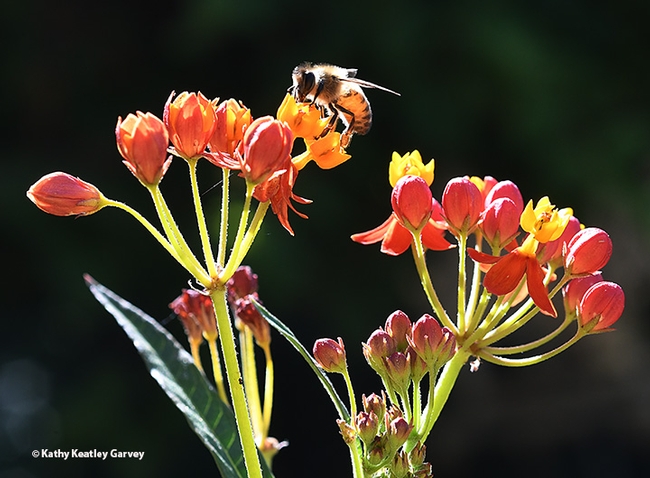
A honey bee forages on tropical milkweed, Asclepias curassavica, in a Vacaville pollinator garden on July 27. (Photo by Kathy Keatley Garvey)
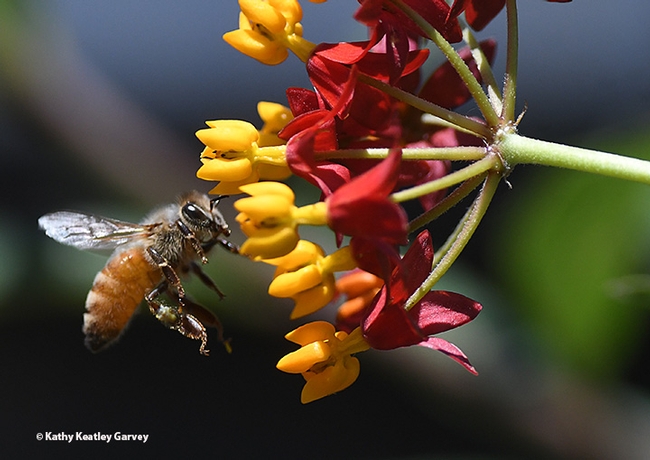
A honey bee makes a beeline for the tropical milkweed,Asclepias curassavica. (Photo by Kathy Keatley Garvey)
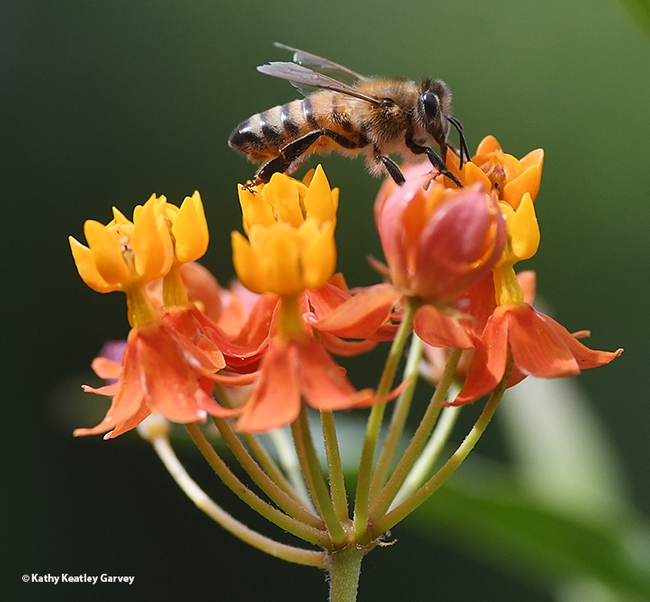
Honey bee nectaring on the tropical milkweed. (Photo by Kathy Keatley Garvey)
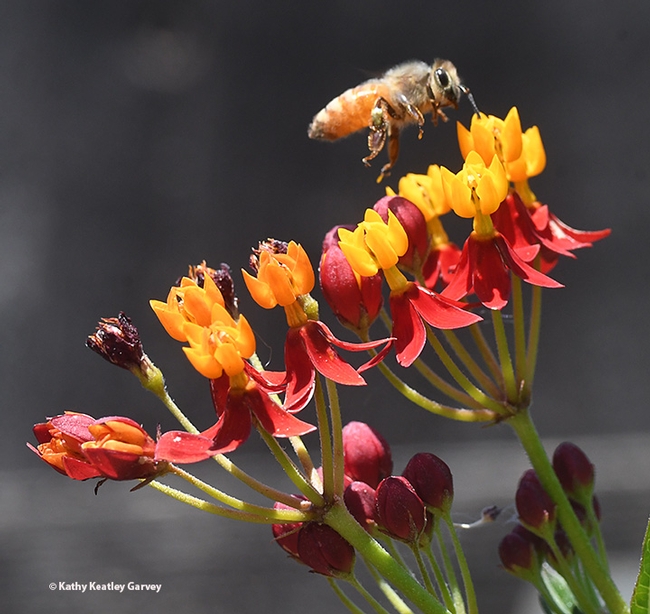
Up, up and away toward the next tropical milkweed blossom. (Photo by Kathy Keatley Garvey)
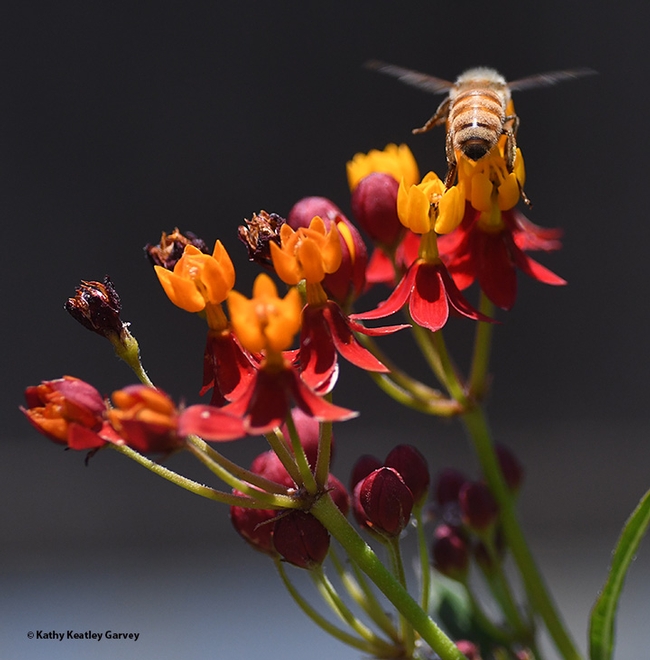
Honey bee takes flight, returning to her colony. (Photo by Kathy Keatley Garvey)